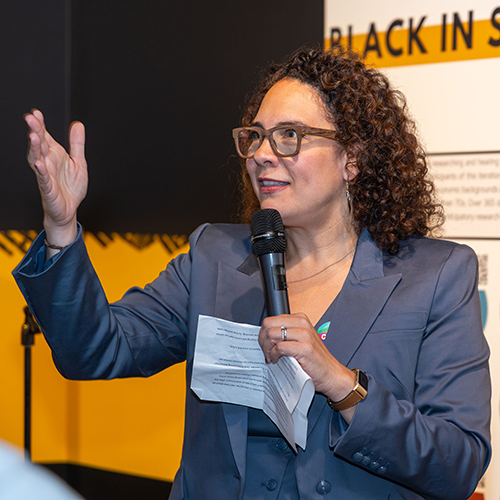“One beam. One damn beam.”

Anne Stewart, general manager for production at the School of Drama, marvels over the troubles caused by a massive hunk of wood that supported the UW’s Playhouse Theatre roof for most of the theatre’s 78-year history. The beam’s low clearance limited the incline of the seating bowl, complicated lighting, and affected acoustics. “It really impeded what you could do,” says Stewart.
Thanks to a major renovation completed this year, that pesky beam has now been moved. More important, all major building systems have been upgraded, and safety issues—including asbestos abatement and a seismic upgrade—have been addressed. The theatre, located at 4045 University Way NE, officially reopens October 30 as the Floyd and Delores Jones Playhouse. A free community open house, to include tours of the building, will be held October 2.
An Intriguing History
The Playhouse dates back to 1931, when Florence and Burton James remodeled a tile warehouse as a performance space, the Seattle Repertory Playhouse. The theatre soon housed one of the few Negro Theatre Units in the country, created as part of the Work Progress Administration's Federal Theatre Project. It also boasted one of the nation’s largest theatre education programs. The Playhouse’s controversial productions eventually led the Jameses to be investigated for un-American activities by the Canwell Committee in 1948, a dramatic chapter in the theatre’s history. (For more about the Jameses and the Seattle Repertory Playhouse, click here.)
The UW purchased the building in 1950 and renovated it in 1967 under the leadership of Greg Falls, then-director of the School of Drama. The renovation brought one significant change: a switch from the existing proscenium stage, in which the performance is “framed” for the audience, to a thrust stage that brings the audience closer to the action.

Since the 1967 renovation, the theatre has seen years of constant use with no major updates. Not surprisingly, its electrical, heating, plumbing, and ventilation systems had begun to fail in recent years. It also was far from ADA (Americans with Disabilities Act) compliant, lacking even an elevator. And the building was seismically unstable, with walls of unreinforced brick. “You could grab a brick and just pull it out,” recalls Stewart, shuddering at the thought. “And those were the walls we were saving.”
In fact, the three outer walls and the gable ends were just about all that was saved from the original building. The rest was gutted, making way for systems more suitable for the 21st century.
Planning for the Next Fifty Years
In designing the renovation, long-range planning was paramount. “We didn’t want a fancy building,” explains Stewart, who served as Drama’s project manager for the renovation, “but wanted it to be durable. We put most of the money toward infrastructure.” Stewart offers the example of the electrical system. “It’s a bit overwired for our current needs, because we want the ability to add as needed later on. We want to be sure the building will still be usable in 30 or 40 years.”
Designed by Seattle’s LMN Architects and built by Wick Constructors, the renovated Jones Playhouse includes natural ventilation, low-flow plumbing fixtures, and lighting that balances sustainability with theatrical functionality. For its emphasis on sustainable design, the building received a Leadership in Energy and Environmental Design (LEED) Gold rating from the U.S. Green Building Council—the first U.S. theatre to earn this rating.

Other welcome features include improved acoustics, infrared assisted listening devices, an elevator, movable seating for wheelchair accessibility, and an expansive dressing area. There’s also a catwalk for changing the lighting—a significant improvement for lighting technicians who previously climbed tall ladders to reach the lights, sometimes balancing the ladder on theatre seats.
Which gets back to that pesky ceiling beam. The catwalk would not have been possible without moving the ceiling beam, nor would the building’s improved seating configuration. Yet those improvements almost didn’t happen. Only after a major gift from Floyd Jones was the School able to move the beam and raise the roof higher.

“That allowed us to raise the seating bowl, so you’re much closer to the action and the acoustics are better,” says Stewart. “It makes the audience feel more engaged.” Raising the roof also made possible an upstairs dressing room, a more open lobby space, and larger restrooms.
A Successful Test Run
All of these features were tested when the School of Drama held its “soft opening” for the building last spring. Although the theatre’s official reopening gala is scheduled for October 30, the School presented Our Town in March as an opportunity to test the new systems and work out any kinks.
Stewart likens the soft opening to an informal dinner prior to a more formal feast. “We picked Our Town for the soft opening because it’s not a technically heavy show,” explains Stewart. “We just wanted to make sure everything was working as it should. You wouldn’t renovate your kitchen and have a big Thanksgiving dinner as your first chance to try things out.”

The verdict? There were a few minor glitches but no major disasters. That’s good news, given that the season opener in October will be The Tempest, a play with many more technical demands.
"There’s a huge storm and a shipwreck, there’s magic…all kinds of different stuff,” says Stewart, thrilled with the prospect. M. Burke Walker ’70 (MA) will direct the production—particularly fitting given that Walker played the lead in the inaugural production after the last renovation in 1967.
For Stewart, the opening gala will cap more than three years of work on the project, from planning to design to construction to testing. “I’ve been involved in a number of renovations on campus, but this is my baby,” she admits. “We couldn’t have had a better team or a better result. It’s an exciting place for our students to work. There’s nothing in this space that limits what kind of show you can do. It really gives our students all sorts of possibilities.”
More Stories

Interrupting Privilege Starts with Listening
Personal stories are integral to Interrupting Privilege, a UW program that leans into difficult intergenerational discussions about race and privilege.

Dancing Across Campus
For the dance course "Activating Space," students danced in public spaces across the University of Washington's Seattle campus this spring.

Read or Listen to Faculty Favorites
Looking for book or podcast recommendations? We asked faculty who've been featured in Perspectives newsletter during the past academic year to suggest a personal favorite.